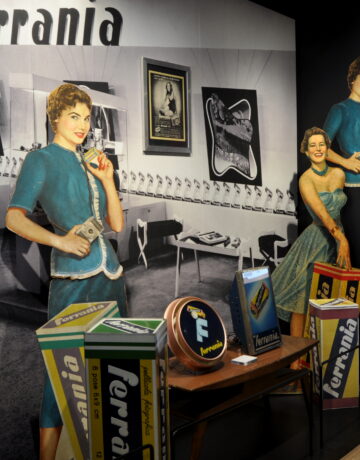Markets and Advertising
The commercial management of Ferrania F.I.LM. was in Milan and handled various marketing services, economic studies, exportation, and advertising while the headquarters for the film sector was in Rome.
 The sales network, entrusted to wholesalers and local officials, benefited from autarchic policies: imported products cost 30% more, due to duties. Already in the early 1950s Ferrania was selling its films in 60 different countries around the world. With the transition to 3M, the branches outside Italy multiplied, as its production and market penetration. The silver pendant, donated in 1988 to employees, gives an idea of the sales volumes of the giant 3M that celebrated the 10 billion dollars. On its back it was engraved “50/50”: half of the turnover from production in the USA, half from the rest of the world. The market was split between the USA and Canada, Europe (especially France, Germany and Great Britain) and other continents with strategic focus to the “emerging” countries. The Argen plant was located in Argentina whereas in India the Ferrania specialists flanked the local workers in a factory taken over by 3M. At different latitudes, from Japan to South Africa, the commercial sector workers were supported by technical assistants, in perpetual competition – acting on price competitiveness, solution flexibility, quality of the product – with the global giants, such as Kodak, Agfa-Gaevert, Fuji, DuPont, Ilford.
The sales network, entrusted to wholesalers and local officials, benefited from autarchic policies: imported products cost 30% more, due to duties. Already in the early 1950s Ferrania was selling its films in 60 different countries around the world. With the transition to 3M, the branches outside Italy multiplied, as its production and market penetration. The silver pendant, donated in 1988 to employees, gives an idea of the sales volumes of the giant 3M that celebrated the 10 billion dollars. On its back it was engraved “50/50”: half of the turnover from production in the USA, half from the rest of the world. The market was split between the USA and Canada, Europe (especially France, Germany and Great Britain) and other continents with strategic focus to the “emerging” countries. The Argen plant was located in Argentina whereas in India the Ferrania specialists flanked the local workers in a factory taken over by 3M. At different latitudes, from Japan to South Africa, the commercial sector workers were supported by technical assistants, in perpetual competition – acting on price competitiveness, solution flexibility, quality of the product – with the global giants, such as Kodak, Agfa-Gaevert, Fuji, DuPont, Ilford.
The clients in the radiological field were laboratories and health facilities, while publishers and printers were the clients for the graphic arts – in Italy national newspapers, Yellow Pages, Mickey Mouse comic books and so on. The company was a worldwide leader in photographic films by private brand in fact, millions of rolls were made for 165 Privat Labels especially for large retailers and foreign retail chains that almost covered the whole production of photographic negatives colour.
If in the 60s half of the production was directed outside Italy, thirty years later it reached 80%. The films made “between the loops of Bormida River” were intended for long journeys.
The range of products made in Ferrania was immeasurable and the catalogue consisted of over 10,000 items: primarily films, for the various sectors (photographic, cinematographic, radiographic, graphic arts), of any kinds and formats, from aero photographic films to photosensitive material for CERN in Geneva, in order to record the traces of elementary particles. In parallel to films there were photographic plates and papers, with particular attention to the replication of documents (bromide and chloride papers). There was no lack of the accessories, such as frames for slides, protective filters for dark rooms, splicers for assembly. The catalogue also contained the magnetic product such as Fersonor (for the inserting of sound tracks); tapes for recorders and calculators (the record company Ricordi distributed materials for amateurs); magnetic products for TV. This sector was then developed in the factory of San Marco Evangelista in Caserta which produced recording reels and floppy disk and, in the 80s, videotapes (VCR and VHS).
At the same time in the plant were also being prepared finished and semi-finished chemical products for industry or for the photosensitive sector such as chemical products for treatment, detectors, protective paints, glues and so on. In addition also began the production laboratory equipment (in 1964 was signed an agreement with Pako Corporation for professional equipment), chemical baths and photographic developer, thermostatic system, enlargers such as Fercop, control and measurement instrument. It is not a coincidence that 3M Italia leasing was born in 1980 in order to dedicate to the equipment rental market.
Ferrania/3M has also been a place of services such as consulting, engineering design and realization, technical support and so on. Before the various laboratories for development and printing became widespread, thousands of photos and amateur filmmakers confidently sent their films to Ferrania, so in 1958, precisely to help this expansion, the Ferraniacolor treatment was liberalized.
